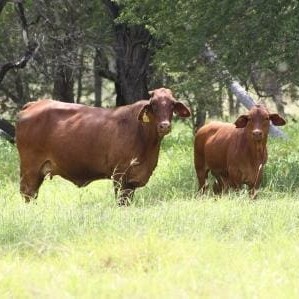 The cost to industry of the widely-acknowledged rundown in sown pasture productivity across northern Australia's grazing lands has been conservatively estimated to be around $17 billion during the next 30 years.
The cost to industry of the widely-acknowledged rundown in sown pasture productivity across northern Australia's grazing lands has been conservatively estimated to be around $17 billion during the next 30 years.
That alarming prediction which involves some 12 million hectares of established improved pasture – 75 percent being buffel grass – has promoted Meat and Livestock Australia to fund a five year investigative project led by Toowoomba-based Queensland Department of Agriculture, Fisheries and Forestry pasture agronomist Brian Johnson.
Mr Johnson teamed with DAFF senior pasture agronomist Stuart Buck, Biloela, to address a Beef Australia 2012 seminar to outline where the project is heading to research practical solutions to the problem. The project was now actively seeking on-farm producer cooperators.
Mr Johnson said pasture rundown affects all pastures including native black speargrass and is essentially a reduction in the biomass over many years of grazing pressure.
"Every producer is aware of the visual symptoms of buffel grass rundown which includes yellowing of leaves, reduced number of seedheads, thinning of the overall plant population and invasion of other less productive species," Mr Johnson said.
"Where this rundown is well advanced, buffel grass productivity can be reduced by 50pc. This can lead to a 50pc decline on animal production through reduced stocking rates.
"The loss of the more productive sown pasture grasses makes it much more difficult for producers to meet targeted premium market specifications."
Mr Johnson said when sown pasture country was initially cleared and developed, there was an immediate release of soil nitrogen to boost plant gowth.
Under long term grazing conditions, these pastures lose 2kg of N/ha/year whereas cropping soils lose 20kg of N/tonne of grain produced.
Mr Johnson said in a rundown pasture situation, the bulk of the soil nitrogen was not actually lost to the system but it was tied up in an organic pool.
Stuart Buck said impacted producers needed to weigh up their economic options.
"There is the 'do nothing' option where the producer can accept the decline in production, reduce the stocking rate and provide feed supplements," he said.
"Another avenue is to add nitrogen fertiliser but even adding urea fertiliser at the rate of 100kg/ha has a limited response and does not stack up economically.
"That leaves introducing a suitable legume to provide the best benefit:cost ratio by using the legume to fix additional soil nitrogen which is then available to boost grass growth."
" We know stylo legumes can fix 20-50kg of N/ha/year.
"By incorporating a stylo legume into buffel pasture, it can lift beef production by 40-60kg liveweight/head/year and use of leucaena can add 70-110kg lw/hd/yr," Mr Buck said.
Mr Johnson said the challenge for landholders was to find the best performing, most sustainable legume to match a wide range of soil types from heavy clays to sandy loams as well as variable climatic conditions.
"To get the legumes established in the rundown pasture, forward planning was vital and the operation should be treated like a any crop by reducing grass competition and planting on stored soil moisture," he said.
"Only buy good quality, high germination seed, inoculate prior to planting and do not skimp on the sowing rate.
"Legumes need fertiliser and to maintain the optimum grass/legume mix and long term productivity, graziers must manage stock numbers and adopt seasonal spelling," Mr Johnson said.
